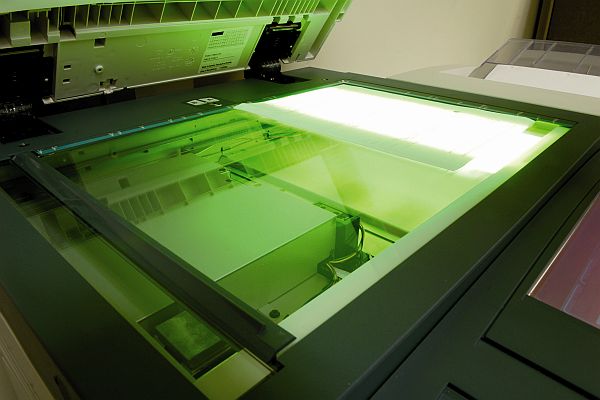Published on the 27/09/2010 | Written by Johanna Bennett

Office copiers have been transformed into business process management tools. We look at some of the offerings available and find out what they can do to make document management easier… and deliver your coffee just so, too…[View as PDF]
Order your coffee via your photocopier? It’s weird, but some modern copiers can do just that. Although you might not fancy your machine doing so, Fuji-Xerox has one set up at its headquarters to do just this, as a way of demonstrating how versatile the modern copier has become.
Of course, it’s not attached to a coffee machine… instead it sends an email to reception to bring you a flat white or long black, or whatever.
Obviously a sales demo, it nevertheless serves to illustrate the fact that the office copiers are so much more these days. And the once-were-photocopier suppliers have been transformed into document management specialists, moving well beyond the realms of merely photocopying in the process. The machines have also changed their name along the way and are usually called multi-function devices (MFDs) now, reflecting their enhanced capabilities.
As well as being printers and now usually scanners too, the new photocopiers aren’t actually copiers at all as we once knew them. They now come bundled with document management and workflow software to deliver business process management (BPM) capability.
Document management software and increasingly ERP (Enterprise Resource Planning) systems are now integrated with MFDs and are used to track documents’ journey, archive them and make them easy to retrieve. The latter facility is not to be underrated if you have ever had to spend hours trying to track down an essential paper file that’s gone missing.
MFDs can now talk to MS Exchange, Lotus Notes, SharePoint and ERP software via middleware. This allows them to undertake a huge variety of tasks, from assigning metadata to aid document retrieval; to controlling who has access to documents; to identifying who has sent emails. They can also aid workflow and help manage storage.
The latter is becoming a major issue, with legal compliance requirements increasing markedly in the wake of the Global Financial Crisis. Compliance is still quite light in New Zealand, but requirements will get heavier as the countries we export to get stricter about it and the Public Records Act is put into force next year.
On a more practical level, the new souped-up copiers can ‘talk’ to your server, making document management much smoother and less scary. MFDs aren’t so new, having been around for four to five years now. However, until recently they’ve been confined to the corporate world, so haven’t had a high profile. But prices are now dropping to the point where some SMEs (small- and medium-sized enterprises) can afford them too.
“Our machines are now portals to get into other applications, whether it’s Sharepoint, TRIM, Hummingbird, Lawbase or Syteline. We can link them to various workflows.”
They still have their place in the big corporate and government world, but ordinary businesses are also starting to discover just how useful they can be. Fuji-Xerox solution specialist David West says that the company is seeing interest from the smaller accountancy and law firms, as well as companies that have to deal with a lot of inventory and invoicing. Fuji-Xerox is actually in the process of developing a bar-code system to help its clients scan and file purchase orders automatically into their ERP system.
“Our machines are now portals to get into other applications, whether it’s Sharepoint, TRIM, Hummingbird, LawBase or SyteLine. We can link them to various workflows,” says
West.
‘Talking’ gets the job done
The link between the copier and business software is middleware, such as the eCopy and Kofax document imaging software, which allows MFDs to ‘talk’ to software. Canon solution specialist Mike Hooker explains: “The business solution side [of the workflow] was separated from scanners, or MFDs, for a long time. Now, through these technologies, they are starting to talk to each other and we are starting to see organisations wanting to utilise the infrastructure they’ve already purchased.”
“Traditionally, 80 percent of information is not stored in a relational database structure. It’s either a piece of paper, in someone’s head, on the local laptop, or a piece of email, something like that. The trick is to consolidate all that information and get it into a manageable repository,” says Hooker.
Canon and Fuji-Xerox are seeing the integration of scanning with BPM in several specific areas: to manage invoicing and purchase orders; to manage email communications, for law firms in particular and government departments in general; and for remote document management.
Distributed capture is the name given to managing scanned documents remotely. Hooker says it is the fastest growing area when it comes of MFD use. It is particularly useful for getting information from remote offices and putting it into workflow. For example, it can be used to automate accounts payable rather than having the job done manually.
“Lots of organisations are looking at systems where you scan in these document images, strip the information and put it in the ERP system, then put it into workflow and approve the invoice, which makes for a much more efficient accounts system,” says Hooker.
Fuji-Xerox’s West puts it more cynically. “It means you can find out exactly who’s responsible for an invoice, instead of getting on the phone and asking, ‘Have you received this?’ and getting, ‘No, it’s lost in the post’, when really it’s under a whole layer of documents on their desk and they haven’t got around to it.”
Distributed capture aids document security in this way too – no more ‘lost’ documents – and you also have “immediacy of information”, says Hooker, as that information is now available to everyone who needs it, while the person who generated it still retains control of it.
Business efficiency is the biggest driver behind take-up of BPM-integrated scanning in New Zealand, says Hooker. “And that’s where the accounts-payable solution comes into play for the CFO – they can get a quick ROI when they start to plug into MFDs.”
| Helping Doctors You’d think hospitals would be a shoe-in for document management systems. Well, the health sector is a real laggard when it comes to taking up technology, but there is some interest in using scanning-based BPM, says Fujitsu’s Mark Broome, who specialises in “intelligent data management”.One use of DMS (document management systems) that has caught doctors’ interest is ‘search’ and the use of keywords to search through patients’ health records.“These can be 200-300 pages long and a clinician might need to search through the whole lot to find a patient’s discharge details, or information about allergies or medication. Search can help with this.”What is standing in the way here though is the huge task of scanning all those paper patient records into electronic storage. But the search facility and the promise of being able to rationalise people’s NHI (National Health Identifier) numbers is a lure here. The goal is for people to have just one NHI number, making for easier document management. But many people have several. This often happens if they have presented at different hospitals.Using metadata and keywords, documents can now be classified down to the page level, says Broome. This could not only help with the NHI number problem, but also with research. |
“Take-up in Health is good but slow,” says Broome. “It’s affected by the current change of government and the present economic climate, which means there’s caution around what projects are taken up.”
However, the valuable information that can be mined out of patients’ records for research purposes, to improve New Zealanders’ health, is an incentive to better manage health documents.
Secure email
Another growing use of software-enhanced MFDs is email authentication. This is of particular interest to legal firms, which must ensure that documents are authentic, so need to know who sent them and be able to create an audit trail for documents. This ‘compliance’ issue, as it is termed, is about to become much bigger in New Zealand as the Public Records Act starts to bite next year, when PRA inspections start, says Hooker. Although it mainly affects public organisations, those who deal with them will be also affected. In addition, exporters and companies that are subsidiaries of US firms in particular face heavier compliance demands to ensure their paperwork is in order.
Law firms copy and email a lot of documents, but, surprisingly, aren’t always very efficient about this – even though some have to do so late at night when there is no secretarial support. Simpson Grierson is a large NZ law firm, with 420 staff spread between Auckland and Wellington. It brokers a lot of big deals – and generates a lot of documents. It wasn’t coping and was getting buried under the paperwork that it was also having difficulty sending to clients around the world.
 Canon’s solution to the paper deluge and communications problem was to install 55 networked MFDs, equipped with eCopy document management software that can integrate the paper and digital worlds, and allow you to scan and email a hard copy document to anyone, anywhere, straight from the MFD. It also creates an audit trail in the process, so improves security. In addition, it interfaces with Microsoft Outlook, so emails are automaticallylogged in users’ sent items folder.
Canon’s solution to the paper deluge and communications problem was to install 55 networked MFDs, equipped with eCopy document management software that can integrate the paper and digital worlds, and allow you to scan and email a hard copy document to anyone, anywhere, straight from the MFD. It also creates an audit trail in the process, so improves security. In addition, it interfaces with Microsoft Outlook, so emails are automaticallylogged in users’ sent items folder.
That audit trail is created because, unlike simpler MFD email systems, the integration with Outlook makes it clear who sent what email where. Newer software enhancements now allow for encryption too, which enhances security even further.
Browser makes it easy
When it comes to modern copier-scanners, or MFDs, it’s all about the browser. This is the portal that gives the user access to… well, whatever he or she wants. But, before the browser, there is the password, the swipe card or, now, the bar-code. This is what gives the user access to the machine. It can be programmed to give different people different permissions for, say, black and white or colour copying, and to access different applications. For example, the finance manager would have access to account information that others wouldn’t have.
Fuji-Xerox’s modern MFDs come equipped with particularly user-friendly web browsers. They look like mini PC-screens and have touch functionality that allows the user to access various applications. While the basic software is Japanese-made, integration to other applications is done by a local in-house development team based in Auckland.
“This means we can find out what genuinely affects NZ businesses and how we can use this technology to help businesses, rather than forcing the Japanese model on to them,” says Fuji-Xerox marketing manager Richard Penny.
Accordingly, the look and feel of the browser interface can be customised to meet different needs. Fuji-Xerox’s David West explains that a warehouse person might have two or three option buttons on the screen, while there would be a much wider range of options for the finance manager. Access, and security, is achieved by means of ID swipe cards, plus, possibly, a password to access, for example, the user’s email account or SharePoint document management files.
“It depends on what the company we’re doing the customisation for wants,” says West. “They might not want the extra [password] step. They might say, ‘I just want the document scanned by a given user.”
But the password option has advantages. The fact that the view of, say, SharePoint files that appears on the MFD’s browser screen is identical to what appears on the user’s PC not only makes for a comfortably familiar experience, it also means that “instead of sending a scanned document to a scan file, and trying to find it, you can select where it is going and it goes straight into your files,” says West.
Bar-Codes make it easier
The latest development is the use of bar-codes to enhance both scanning into ERP systems and to aid subsequent retrieval of purchase orders and invoices.
This system is being developed in-house by Fuji-Xerox’s Auckland development team. It’s a simple but elegant solution to managing multiple invoices and purchase orders in particular.
“Basically, if the document I scan has a bar-code on it, the machine will recognise that bar-code and file the document away based on that bar-code,” says West. It takes out a lot of manual steps and allows for easy document retrieval.
West says a lot of clients are now using this system. For instance, Tip Top, the icecream maker, now generates invoices with pre-printed bar-codes. “The invoice is then scanned into the server, which recognises the bar-code and automatically files it in the right place. The document is effectively named with the bar-code, so you can now go into the ERP system, enter that bar-code number and click on the link that comes up, which takes you to the invoice [that perhaps you want to query].”
“This saves time on entering document information, or scanning it in, then dragging it to where it needs to go and re-naming it,” says West. The process also takes out a lot of manual steps, so admin clerks no longer find themselves sifting through physical files to answer queries.
As West puts it, the aim is to “deal with it once”, so improving business process efficiency – and to make dealing with it once easy.
“We now talk about paperless filing. It’s a case of ‘scan once, view many,’ so it’s available to everyone who needs access to it, because you captured the information.”
Future: Growing and green
And what about the future? Canon’s Mike Hooker sees a growing move to scanning. But there has to be a push to get organisations to do so, he says. This can be an office move or the rising cost of real estate. Such caused Canon itself to digitise old manuals using scanners, to cut down on its files when it moved offices.
“But the paperless office is not going to be a reality,” says Hooker. “We now talk about paperless filing. It’s a case of ‘scan once, view many’, so it’s available to everyone who needs access to it because you captured the information.”
Fuji-Xerox’s Richard Penny has quite a creative view of the future. He says local systems integrators are already looking at new ways of using the technology. Automated capture of marketing information and surveys – and making this information available to CRM (Customer Relationship Management) systems – is one area of interest, he says.
Schools are also using it to automate, for example, form-filling. He gives the example of students scanning in their signed forms for a school trip, and having parent signatures ‘searched’ and compared with a stored example. More positively, a school in Albany, north of Auckland, has been scanning in children’s artwork and putting it up on a webpage for parents to view.
 Penny says the technology is also going green and cites the fact that some components of Fuji-Xerox’s machines are now made of a biomass plastic that is 30 percent cornderived, making it both bio-degradable and less energy intensive to manufacture – its carbon footprint is 16 percent lower than that of conventional plastic. The company is also using lead-free shafts in its MFDs.
Penny says the technology is also going green and cites the fact that some components of Fuji-Xerox’s machines are now made of a biomass plastic that is 30 percent cornderived, making it both bio-degradable and less energy intensive to manufacture – its carbon footprint is 16 percent lower than that of conventional plastic. The company is also using lead-free shafts in its MFDs.
| Why Metadata Matters Metadata could become a new buzz-word as document management becomes more important. It means to assign properties to a file, typically, name, location, type f document or a pre-set (say, contract, sales brief); ‘types’ can include PDF or TIF. Keywords can also be assigned. This eans the user can go into, say, MS Sharepoint or another document management system and search for documents sing keywords. The barcode technology that Fuji-Xerox is developing is a further enhancement here, as it allows the machine to read the number embedded in the barcode and send a document to where it’s supposed to go based on just that.However, Fujitsu’s Mark Broome adds a cautionary note. “Scanning is fantastic – providing you can find it later.”Which is why you need to pay close attention to the metadata you attach to documents.As well as thinking about making search-and-retrieval as easy as possible, you also need to think about the life of a document, says Broome – do you need store it for two years or 50 years? – and store it accordingly. |

































How are you protecting yourself from copier-related identity theft? What kind of home copier would you recommend?